– Overview
– What is Robotic Surgery?
– History of Robotic Surgery
– What are the most prominent applications of robotic surgery?
– Robotic Surgery Advantages
– Robotic Surgery Disadvantages
– How is robotic surgery performed and is there any risk?
– What a Surgical Robot Consists of?
– Conclusion
Overview
Science and technology are the engines of development and the most important reason for global prosperity, they almost contribute to every field in the world, and they are working to develop them.
When it comes to the medical field, technology has provided remarkable innovations in medicine and outstanding facilities that have helped in controlling a lot of Diseases.
We know that complex surgical operations have become easier than before, so the invention of surgical Robots is one of the most important results of technology in the field of medicine, through which many surgeries are done with the utmost ease and accuracy.
This article tackles multiple information about robotic surgery including, definition, robotic surgery history, robotic surgery advantages, disadvantages, and components of a surgical robot.
What is robotic surgery?
Robotic surgery is a surgical intervention in the human body that is not performed by a surgeon directly, but it’s based on mechanical robots which are previously programmed with computer technology and using commands and information that enables it to perform the surgery as planned without deviation from its plan or dealing with anything else in Patient’s body.
Robotic surgery helps in all surgical operations that rely on laparoscopy in all specialties of endoscopy, robotic surgery does not aim to eliminate the conventional surgery that can be done by surgeons, but aimed at increasing the accuracy and capabilities of those surgeons.
History of Robotic Surgery
The first use of robotic surgery was in Vancouver, Canada in 1985, This surgery happened in Vancouver General Hospital using a robot called Arthrobot, it was used to manipulate and position a patient’s leg upon voice commands, this robot was developed by the University of British Columbia in collaboration with Vancouver General Hospital.
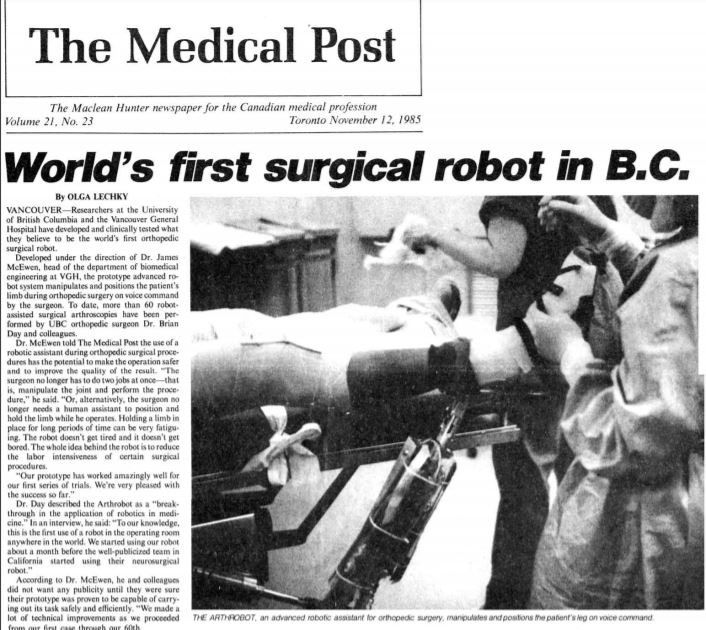
At the same year another robotic surgery performed for cancer patient with a brain tumor, it was done by PUMA 200 in a neurosurgical operation for making a brain biopsy guided by computed tomography, Dr. Yik San Kwoh developed the system that was able to control the robotic arm, that happened after a while of the spread of endoscopy surgery, endoscopy technology has added a great deal of comfort and creativity by making small incisions in human body and it enabled surgeons to perform The most complex surgeries, which led to the emergence of robotic surgery afterwards, Laparoscopic surgeries were subject to some limitations, but with the advent of robotic surgery, the field has been open to removing those limitations, until we became able to perform endoscopic surgeries with 3D imaging technology.
What are the most prominent applications of robotic surgery?
We must know that this technology has unexpectedly developed in the recent period, which enabled it to Participate in a lot of surgeries and dispensing with the regular endoscopy temporarily, or at least this technique has been used in the most famous medical centers in the world due to its novelty.
The most important of those applications that you participate in are: –
1. Robotic Surgery for Obesity
Obesity surgery is one of the most dangerous and difficult things in the current era due to the high amount of fatty tissue, laparoscopic procedures for obesity are the safest and with the highest quality now, especially with the use of robotic surgery technique, the chances of any surgical error or pain are reduced for the patient when removing that fatty part, and it will also be performed through very small incisions.
2. Robotic Surgery for Bowel
Bowel surgery is considered the most difficult due to the narrowing of the small cavities inside the intestine and within the Pelvic region in the human body, these operations can be done well by laparoscopy, however, there will be some difficulties in penetration of the inner tissue and entering those depths, but with The presence of robotic surgery and the possibility to see 3D views with clearer image, There is no room for an error besides patient safety measures that have increased compared to the previous time.
3. Robotic Surgery for General Surgery
It was the first in the medical field in which robotic surgery has been used, it was used in pancreatectomy and hepatectomy which have tumors and need surgical intervention.
Robotic surgery has the greatest merit in facilitating surgeries, especially the dangerous ones, that happened because of the high-tech imaging technology and some surgical equipment that can enter the abdomen of the patient through very small openings, with the ability to see the part to be treated using a 3D camera, you can distinguish between tiny vessels and nerves, which helps to move more precisely between them with a robotic arm.
Compared to a surgeon’s hand that has a ratio Large margin of error, the robotic arm is able to move eccentrically anywhere inside a patient’s body without any error in the operation.
Robotic Surgery Advantages
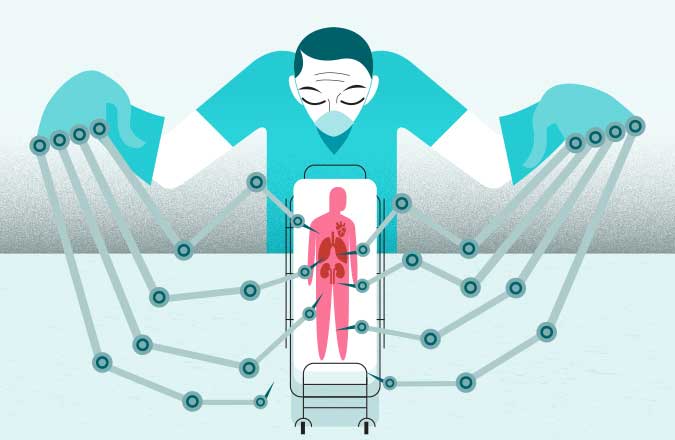
The robotic surgery advantages are varied and the advantages of minimally invasive surgery increase greatly Because of its remarkable technology and its continuous development, the main advantages that make you believe in robotic surgery are
1- Higher Accuracy
Accuracy in completing the operation, as this can be seen through the doctor’s hand that may be unable to access to the smallest areas of the body, but surgical arms and robotic endoscopes provide undoubtful precision that helps it to reach the most accurate and sensitive areas during the surgery.
Surgical robot arms are more flexible in their movement, the movements of a surgeon in the control unit can be translated into very precise and 3D flexible movements, also robot arm is more stable and steady in its movement when compared to a surgeon’s hand that might shake or be subjected to tremors especially in the sensitive surgeries.
Robotic surgery delivers excellent results and has a good success rate that ranges between 94% to 100%.
2- Speedy & Productive
Robotic surgery is characterized by higher speed and it can save time up to 30% compared to conventional operations, and therefore more comfortable for the patient and surgeons.
3- Better Visibility & Less Fatigue
In conventional surgeries, surgeons are depending on their own vision under the operating room lights, but with robotic surgery, they now have better visibility through the high-resolution and high definition images on the screen and magnified as well, they are also able to see areas where they couldn’t be able to see before.
For surgeries that continues for multiple hours and surgeons are standing up all the times, surgeons are subjected to fatigue and less concentration, but this is not the case in robotic surgery as machines don’t know the term “fatigue”, also surgeons are sitting comfortably rather than standing up, so they can feel better and be focused all of the time with good visibility of the magnified 3D image, that leads to more accuracy and fewer errors that might arise in long time surgeries.
4- Remote Surgery with 5G Technology
With the emergence of 5G technology, ultra-high-speed connectivity enabled surgeons to perform telesurgery with less latency almost real-time machine response.
The 5G technology provides a high speed of data transfer, almost 2 milliseconds lag between devices. this technology will have a massive application in healthcare and telesurgery is one of these applications.
The first time to apply telesurgery was in Beijing, China in 2019, it was a brain surgery over 1,500 miles away for a Parkinson’s disease patient.
Dr. Ling Zhipei performed a deep brain stimulation implant for that patient in surgery for almost 3 hours, Dr. Ling performed this surgery from Hainan city successfully with help of 5G technology that eliminated the known issues of lag and delay known in 4G technology.
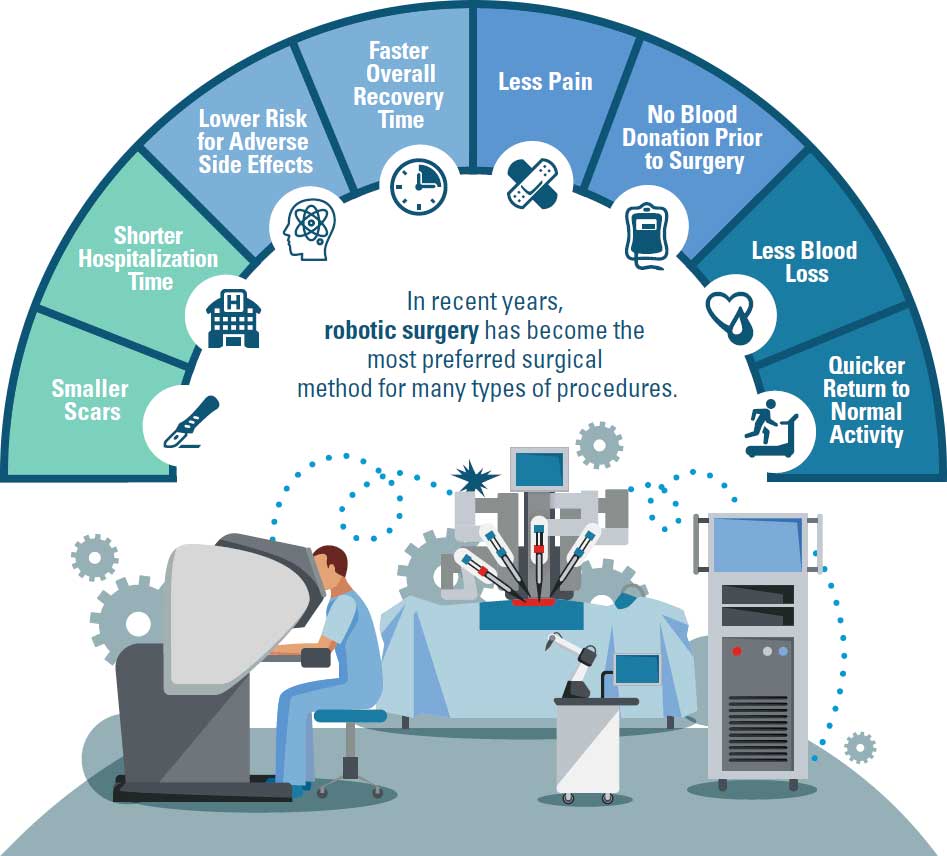
5- Better Patient Experience
The patient exits the hospital and gets back to his normal life in a shorter time after the operation, which may allow patients to leave the hospital only one or two days after the operation.
Patients are subjected to smaller incisions, minimal invasion, and less pain during the surgery when compared to conventional surgeries.
The complications arising from anesthesia in robotic surgery are much less than the complications resulting in cases of anesthesia as a result of other conventional surgeries.
It can handle the most complex tumors and cancers, and its ability to enter very sensitive and small sites In order to eradicate it.
Robotic Surgery Disadvantages
1- High Cost
One of the important robotic surgery disadvantages is its high cost for providers and patients as well. a single surgical robot system might cost USD 2 million, so it’s not a budget-friendly solution for multiple healthcare providers.
Also for patients, robotic surgery cost is higher than any other laparoscopic surgery from USD 3,000 to USD 6,000. so it may not be the optimum choice for patients due to its high cost.
The continuous development of robotic surgery systems to improve the quality and add better functionalities makes the older versions obsolete and needs to be replaced, which will increase the cost along the way and will be a burden.
2- Required Technical Expertise
The usage of a surgical robot requires massive training for surgeons, it’s like learning surgery all over again. there are no many experts who know how to perform robotic surgery, that’s why robotic surgery might not be widespread due to the lack of experts who can perform this kind of surgery.
3- Less Haptic Feedback
Sometimes, surgeons depend on their sense in surgery procedures, from their own experience they might feel if something is right or wrong depending on haptic feedback.
As an example, Surgeons can feel different haptic responses while making an incision, there is differentiated tactile feedback when cutting different types of tissues like skin, muscles, ….etc.
In robotic surgery, this feedback is minimized and not noticeable, that might increase the risk of injuring other organ or more nerve damage, innovators of surgical robots are working on this issue to provide more responsive robots with semi-real haptic feedback.
How is robotic surgery performed and is there any risk?
Although its name is robotic surgery, it does not mean that it works by itself and gets rid of the surgeon, it is not possible to be performed without the supervision of a surgeon, it still has the same risks and complications as traditional surgery.
After all, the robot is a machine, it cannot think but it helps the surgeon to perform the most difficult and complex tasks, and the surgeon has complete control over all movements.
From the robot’s side, it carries out the command and performs the most difficult surgeries with precision, Regular endoscopy or even conventional operations may not deliver the required result efficiently. However, through robotic surgery, the surgery is performed under the supervision of a trained physician so the surgery will end very successfully.
What a Surgical Robot Consists of?

The surgical robot consists of 4 main parts which are:
Patient’s Bed
It’s the first part of the system which is a table where the patient lay down, two or three arms are attached to this table according to the need, for example in some surgeries four arms are used, with the help of these arms it is possible to enter the patient’s abdomen in order to complete the surgery, and one of these arms contains a camera to view the work of the arms and display it on the screen in Surgical control unit.
Surgical Tools in Robot Arms
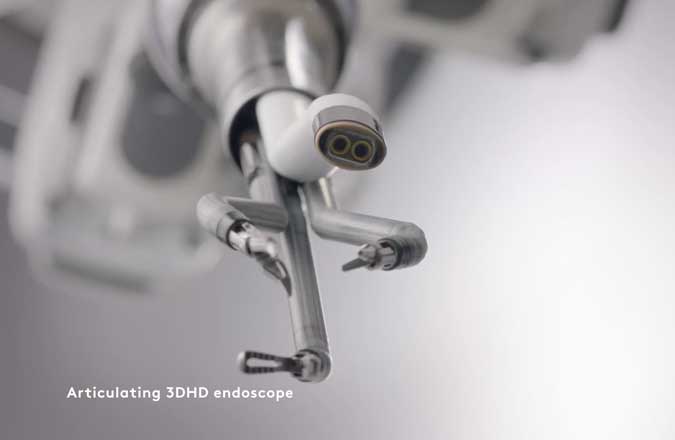
The arms are made and programmed to perform movements similar to the movement of the human hand but with a higher precision, which leads to suturing (closing) the incisions after the completion of the surgery in a better way than what the surgeon can do with a human hand.

The tip of this arm (wrist) can rotate around itself a full cycle with control from the surgeon with the required strength, and it ranges from a fraction of an ounce to several pounds (a unit used to measure weight and is also used to measure strength), and this arm also has the advantage of not trembling or changing the horizontal level of work, which provides more control and precision.
3D Imaging System
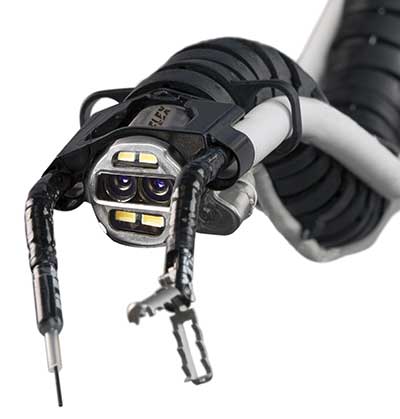
This endoscope is installed on one of the arms used during the surgery and broadcasts a modified three-dimensional image to the screen in the control unit, and this device gives about a thousand clear, high-resolution images of the movement of the surgical instrument per second and is filtered to prevent blurring of the background on the images of the surgical instrument and during its movement.
This vision system is programmed to adjust the temperature to the side in order to prevent the appearance of fog in case of temperature changes with an increase or decrease, and the surgeon can adjust the scene to another by means of a pedal at his foot. The device also contains a battery that enables it to work in the event of a power failure.
Surgical Control Unit
This is a unit for the surgeon through which he can control all the robot’s arms and watch the procedures with the help of the 3D camera.
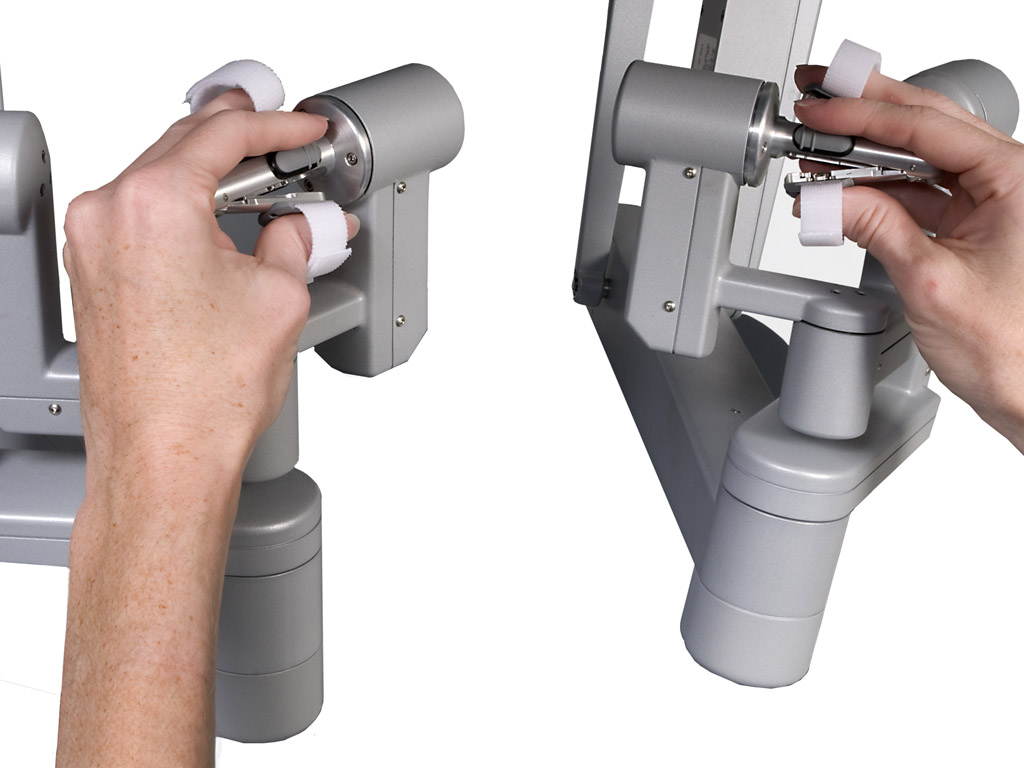
Conclusion
Surgeons hands now are more empowered, robotic surgery is the future of almost all surgical operations that can provide better accuracy and efficiency in the field, there will be a continuous development of more precise planning tools and AI software to increase automation in surgeries and provide error-free surgeries especially in the complex and sensitive surgeries.
A lot of robotic surgery advantages as it will lower the risk for patients and surgeons and improving surgery outcomes, robotic surgery also provides more precision and higher flexibility and control when compared to conventional surgeries, in addition to shorter recovery time for patients with less pain benefit.
All countries of the world are currently witnessing a great development in the field of robotic surgery, as there are many countries developing robots that can execute harder missions, and who knows, we may see in the future that robots will control a field Surgery where nurses and specialists are replaced by robot arms controlled by one doctor.
This will end a lot of randomness and disharmony between the medical team during all surgical procedures, complex surgeries related to delicate tissues and neurology are in dire need of such technology, which contains a degree of accuracy and safety that is not present in conventional operations and is not that much present in ordinary perspectives.
This is the real benefit of science and technology, and they have emerged through the invention of robotic surgery, you can notice the extent of benefits that have been added to the field of medicine in our modern era.


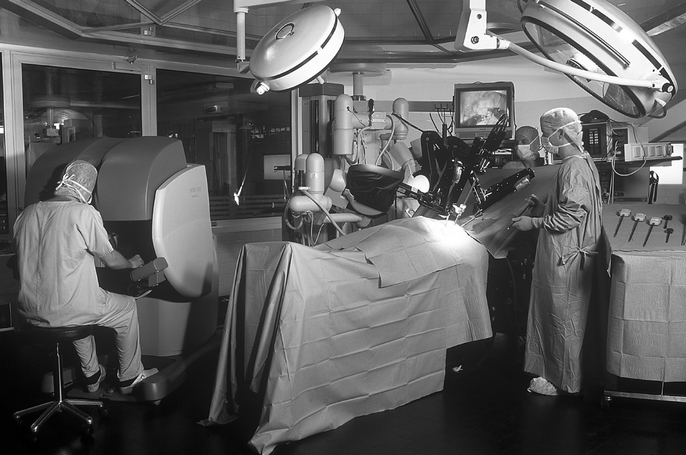
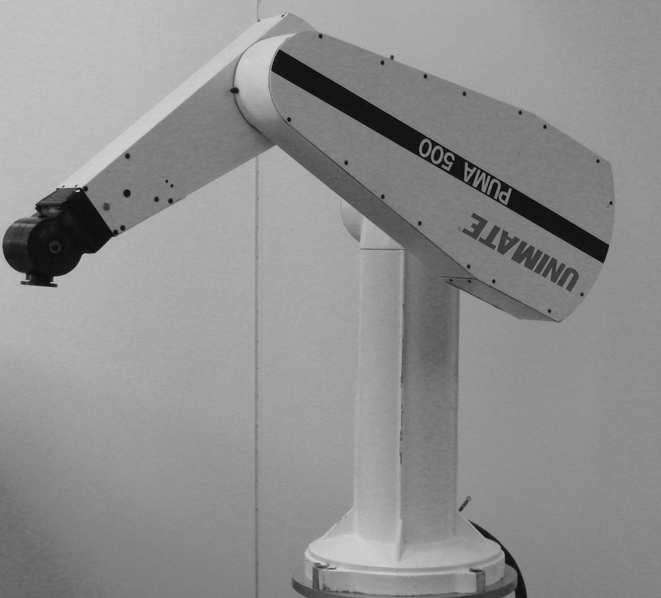
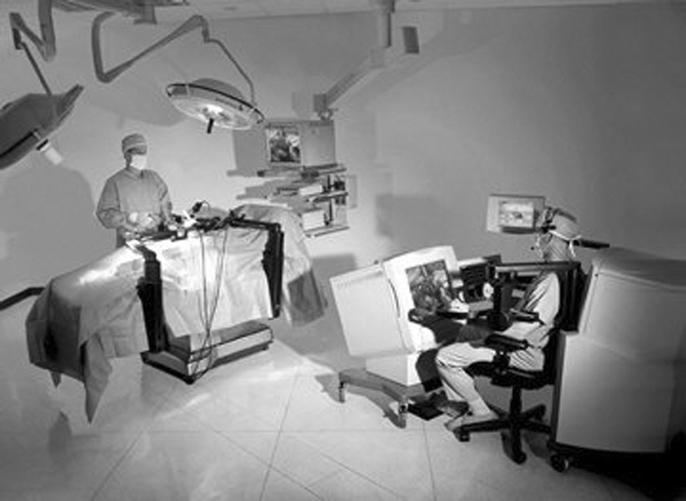
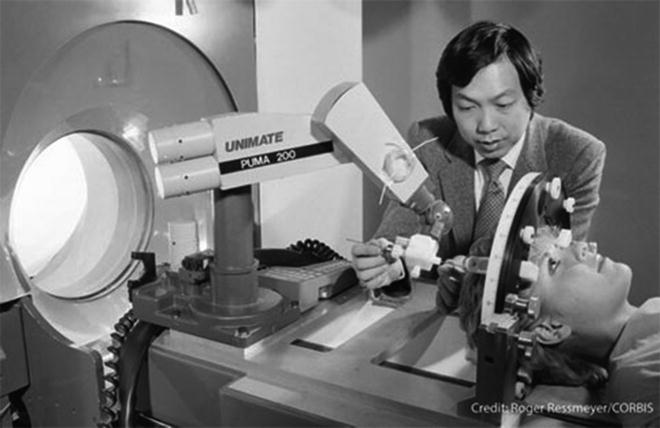
Comments are closed.